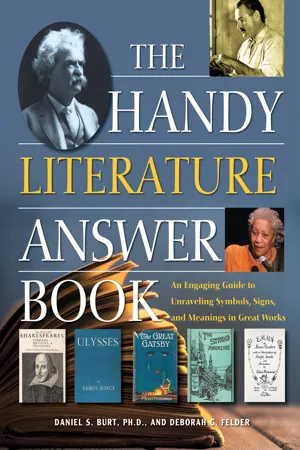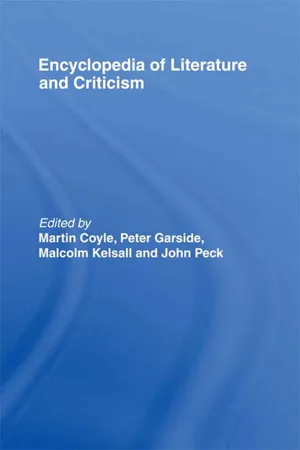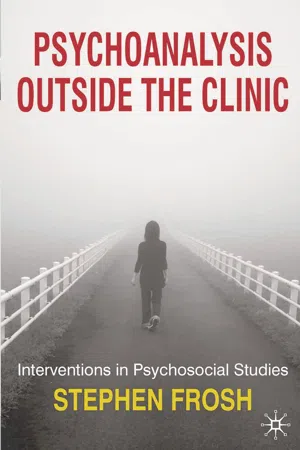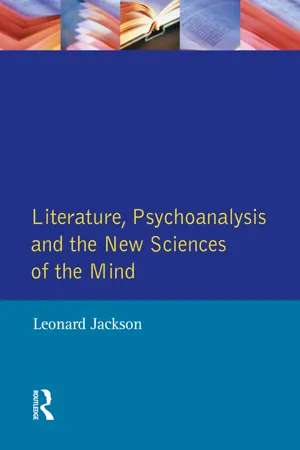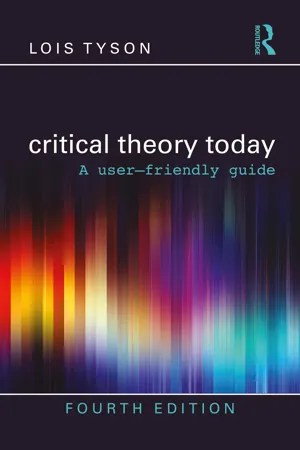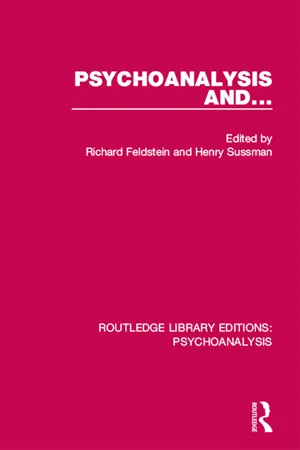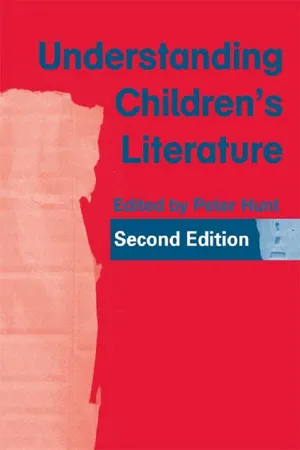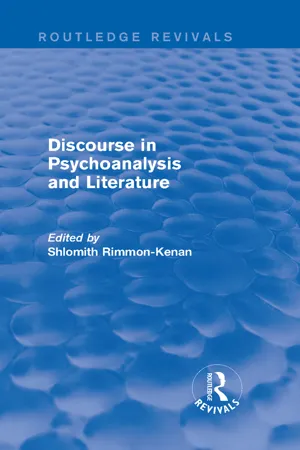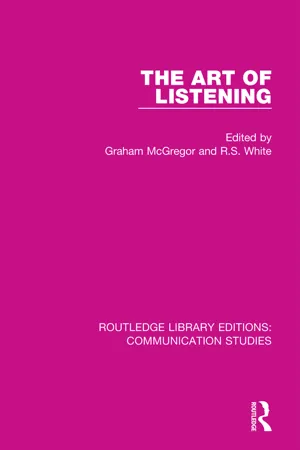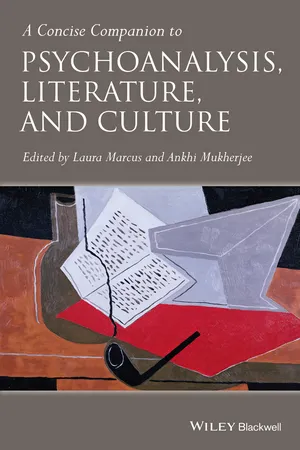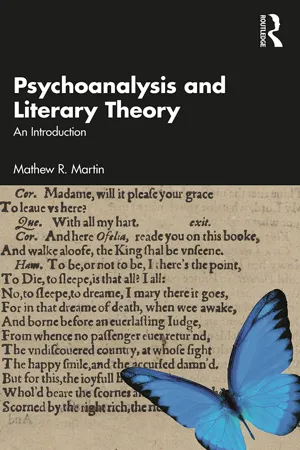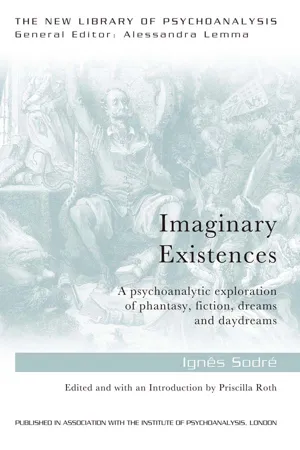Literature
Psychoanalytic Literary Criticism
Psychoanalytic literary criticism applies principles from psychoanalysis to analyze and interpret literature. It explores the psychological motivations and unconscious desires of characters, authors, and readers, often focusing on themes such as repression, sexuality, and the Oedipus complex. This approach seeks to uncover hidden meanings and symbols within literary texts, shedding light on the psychological dimensions of storytelling.
Written by Perlego with AI-assistance
Related key terms
12 Key excerpts on "Psychoanalytic Literary Criticism"
- eBook - ePub
The Handy Literature Answer Book
An Engaging Guide to Unraveling Symbols, Signs and Meanings in Great Works
- Daniel S. Burt, Deborah G. Felder(Authors)
- 2018(Publication Date)
- Visible Ink Press(Publisher)
Poetics placed character just below plot in importance in tragedy, and his analysis of the nature of character needed in drama is the first instance we have of what could be called a psychological approach to literature, that is, the relationship between literature and human character types. Through much of the literary history that followed, through the medieval period and the Renaissance, human psychology was fundamentally regarded as fixed and stable, expressed in terms of clear moral categories (virtue and vice) or by the four fundamental personality types or humours (sanguine, choleric, melancholic, and phlegmatic). It would not be until John Locke (1632–1704), the English Enlightenment philosopher, provided a theory of human understanding derived from experience that a dynamic and developmental concept of human psychology began to emerge. By the eighteenth century, various evolving literary forms—biography, autobiography, and the novel—reflected the Lockian view of the experiential nature of personality that would culminate in a modern theory of psychology, identity, and consciousness as articulated by Sigmund Freud, Carl Jung, and others. The psychological or psychoanalytic approach to literature applies these theories to an understanding and interpretation of literary works.What is Freudian Criticism?Without question, the first Freudian critic of literature was Sigmund Freud (1856–1939) himself, who relied on literature for examples and confirmation of his theory of human nature and development. “Everywhere I go,” Freud declared, “I find a poet has been there before me.” He would, for example, name his most controversial theory of childhood sexual desire the Oedipus complex after the Greek myth dramatized by Sophocles. It is not surprising, therefore, that literature would later serve as case histories for an application of Freud’s psychoanalytical theories that transformed our understanding of human nature and experience. Freud’s core concept of the role of the unconscious in shaping behavior and desires as well as the three parts of the human personality (id, ego, and superego) would lead literary critics to look for an underlying dynamic of Freud’s teachings in literary works not on their surface but in the unconscious motives of both characters and authors. If, as Freud declared, “Dreams are the royal road to the unconscious,” then imaginative literature could be regarded as the symbolic wish fulfilment of the unconscious desires of its author and its characters in the text as embodiment of repression, childhood sexual memory, and neuroses. The Freudian Psychological Critical approach would elevate the importance of biographical information about an author as well as encourage a close reading of a text, not as in New Criticism for the relationship between form and content but for underlying symbolic patterns revealing psychological truths operating in the text. - eBook - ePub
- Martin Coyle, Peter Garside, Malcolm Kelsall, John Peck(Authors)
- 2002(Publication Date)
- Routledge(Publisher)
56 Psychoanalytic Criticism Elizabeth Wright DOI: 10.4324/9780203403624-62Psychoanalysis has problems with its credentials: it is not at present falsifiable and because of this it has not been regarded as one of the physical sciences. Its data depends on the clinical evidence it has defined, and its theory is built on accepting this evidence as true. Psychoanalytic theory, whether Freudian, Jungian, Kleinian or Lacanian, rests on the assumption that sexuality is the constitutive factor in the construction of the subject. Each school has its own mythology and this is often taken by opponents of psychoanalytic theory as proof that it must be nonsense. But this is forgetting that what all the schools have in common is that they find structural images in the mind which point to the way that the present is determined by the past in terms of the subject’s sexual history. The beginning of this history is seen in every case as the sense of loss the subject experiences upon its separation from the mother’s body.What, though, has psychoanalysis to do with literary criticism? Much has been made by modern critics of the analogy between mental and linguistic processes: Jakobson in linguistics pointed to the links via metaphor and metonymy, and Lacan went further with his re-interpretation of the dreamwork’s mechanisms as identical with certain classical tropes. This certainly makes psychoanalysis literary. But if what we really want is to make literary criticism psychoanalytic, another answer would be as follows: if we have any knowledge of the genetic origin of language in the individual and its growth through the interchange between mother, father and child, such knowledge is essential to the understanding of the literary process. Psychoanalytic theory brings out the intentional aspect of language through its concentration on the relationship between sexuality and social role: the unconscious aspect of utterance cannot be left out, when, as clinical practice has borne out, sexuality is so much the component of intention. All such utterance is concerned with the search for representations bound up with the satisfaction of drives. The literary text is a form of persuasion whereby bodies are speaking to bodies, not merely minds speaking to minds. - eBook - ePub
Psychoanalysis Outside the Clinic
Interventions in Psychosocial Studies
- Stephen Frosh(Author)
- 2010(Publication Date)
- Bloomsbury Academic(Publisher)
psychoanalysis’ notice.It is such backwards and forwards movements that promote the kinds of open encounters being pursued here. This chapter therefore takes up this debate over psychoanalysis and literature in order to outline a kind of ‘model’ of what is required to sustain such openness. This will lay some further groundwork for the interventions in subsequent chapters, which explore some exemplary psychoanalytically informed debates in contemporary social and psychosocial studies.Problems of character and interpretation
Psychoanalysis has always been controversial as a method of literary analysis, particularly amongst writers and critics who regard it as a colonising discipline trying to tell the ‘truth’ of literature without necessarily appreciating its specificity, including its aesthetic properties. There is certainly much for such critics to get their teeth into, as psychoanalysts have not been coy about applying their clinical insights to literature. Sometimes, as with Freud, this is because they admire creative writing and wish to understand it better; but often they seem simply unable to resist the temptation to speculate freely about literary characters or their authors, perhaps rejoicing in them as ‘patients’ who cannot answer back. The most outrageous instances of psychoanalytic ‘reading in’ to literary productions treat them as somehow transparent indicators of the mental state and psychobiographical attributes of the author. Examples here include Marie Bonaparte’s (1933) early study of Edgar Allan Poe, which identified necrophilia as a pathological personality state underpinning Poe’s writing, or Ernest Jones’ (1910) study of Hamlet as Oedipal drama. The limitations of this approach and of the parallel tendency to treat literary characters as real have been well recognised for a long time. As noted in Chapter 2 , Freud himself showed anxiety at realising that he was attributing mental processes to the fictional protagonists of Jensen’s Gradiva. Virginia Woolf firmly opposed psychoanalytic criticism on the grounds of its reduction of characters to ‘cases’ (Abel, 1989, p.17). Interestingly, however, Woolf also had some sympathy for the idea that literature might be the writer’s equivalent of psychoanalytic treatment. Writing about the composition of her novel To the Lighthouse, - Leonard Jackson(Author)
- 2014(Publication Date)
- Routledge(Publisher)
But there are traps here. Freudian analysis is intended to provide a basis on which the individual patient can understand and interpret his own life: can indeed, not merely learn about the unconscious conflicts which have been paralysing him, but take that unconscious material into his own ego, so that it becomes subject to conscious decision and control. ‘Where it was’ (runs a correct translation of the famous aphorism) ‘there shall I be’. A literary critical interpretation has something of that flavour: we are in a sense ‘taking possession’ of the inner meaning of the work, just as the patient is taking possession of the inner meaning of his own life. But neither the author nor the reader is actually a patient. In neither case are we using the work (as the psychoanalyst necessarily uses dreams) simply as a way station to the patient’s unconscious. A literary seminar is not (or should not be) a place where people sit on couches and free-associate. The work is an impersonal thing; we don’t know who the next reader will be, and we may not know who the author was. A critical statement, even based on a psychoanalytic theory, can only be true in this impersonal context: that is, it can only be true of a book, and of people in general. A great deal of ‘Freudian’ discussion of literature ignores this obvious point. Most people who are interested in literature are interested in gossip; and gossip about authors is an especially fascinating form of this. In such gossip, a work of art can be treated as a gigantic symptom; and Freudian theory can be employed to diagnose the author, and reveal his personal conflicts. Notoriously Shakespeare, Jane Austen and D.H. Lawrence have been treated in this way. More recently Jacques Lacan 9 celebrated his extension of Freudian theory to cover psychosis by diagnosing James Joyce, on the basis of his early ‘Epiphanies’, as a pre-psychotic who avoided psychosis by writing Ulysses and Finnegans Wake- eBook - ePub
Critical Theory Today
A User-Friendly Guide
- Lois Tyson(Author)
- 2023(Publication Date)
- Routledge(Publisher)
It stands to reason that you won’t find every psychoanalytic concept we’ve discussed represented in every literary work you read. Our job, when we read psychoanalytically, is to see which concepts are operating in the text in such a way as to enrich our understanding of the work and, if we plan to write a paper about it, to yield a meaningful, coherent psychoanalytic interpretation. From the perspective of classical psychoanalytic theory, which is our primary focus in this chapter, we might attend mainly to the work’s representation of Oedipal dynamics or of family dynamics in general; to what the work can tell us about human beings’ psychological relationship to death or to sexuality; to the way the narrator’s unconscious problems keep asserting themselves over the course of the story; or to any other psychoanalytic concepts that seem to produce a useful understanding of the text.Some critics have objected to the use of psychoanalysis to understand the behavior of literary characters because literary characters are not real people and, therefore, do not have psyches that can be analyzed. However, psychoanalyzing the behavior of literary characters is probably the best way to learn how to use the theory. Furthermore, this practice has been defended by many psychoanalytic critics on two important grounds: (1) when we psychoanalyze literary characters, we are not suggesting that they are real people but that they represent the psychological experience of human beings in general; and (2) it is just as legitimate to psychoanalyze the behavior represented by literary characters as it is to analyze their behavior from a feminist, Marxist, or African American critical perspective, or from the perspective of any critical theory that analyzes literary representations as illustrations of real-life issues.Let’s look at a few specific examples to see the kinds of insights produced by using classical psychoanalysis to interpret the behavior represented by literary characters. A psychoanalytic reading of Arthur Miller’s Death of a Salesman (1949 ) might examine the ways in which Willy Loman’s flashbacks to the past are really regressive episodes brought on by his present psychological distress: his own and his sons’ lack of success in the business world, success Willy needed in order to assuage the massive insecurity he’s suffered since his abandonment in childhood by his father and older brother. The play is thus structured by the return of the repressed, for Willy has spent his life repressing, through denial and avoidance, his psychological insecurity and the social inadequacy and business failure that have resulted. From a psychoanalytic perspective, then, Death of a Salesman - eBook - ePub
- Richard Feldstein, Henry Sussman, Richard Feldstein, Henry Sussman(Authors)
- 2015(Publication Date)
- Routledge(Publisher)
2 It is perhaps difficult now, in the wake of poststructuralism, to associate psychoanalytic theory with such reassuring bromides, yet this is representative of the discoure of the psychoanalytic pact with literary humanism. Moreover, under the influence of the same cultural pressures that helped promote the growth of American ego psychology—not necessarily under the influence of ego psychology itself—literary critics in fact sought to reassure the discipline on two rather more crucial fronts. The acknowledged, overt disputation was over the nature of literary meaning and the status of literary creativity and authorship. This was, I would argue, a displacement of the real power struggle—over the status of the literary critic and the integrity of the discipline. Literature was not really the issue at all. The problem was less whether the writer of literature was a coherent, fully integrated, conscious human subject than whether the writer of criticism was.In its rapprochement with New Criticism, or rather its willing self-denial within the constraints that compromise imposed, psychoanalysis supported a view of critical writing wholly at odds with its own theoretical roots. For psychoanalytic critics were implicitly willing to reassure the profession that a critic is not intersubjectively and phantasmatically implicated in his or her own observations, insights, and conclusions about literary texts; that neither the individual nor the social investment of desire—and certainly not the historically specific cultural organization of those investments—is at issue in critical writing; that, most remarkably, one should, as it were, properly remain quite unchanged by anything one learned from the psychoanalytic study of literature. Literary criticism would be an activity able simultaneously to strengthen the critic’s ego and the existing structures of socialization. Moreover, the discipline’s theoretical, social, and political boundaries, with their self-reinforcing idealizations, would remain secure.Instinctively, the conservative members of the profession have known that none of this can be guaranteed, that psychoanalysis as a body of theory implicitly undermines the restrictive contract it makes with academic disciplines. Through the early 1970s—despite their cooptation by the widespread academic resistance to overt self-reflection within critical writing—psychoanalytic critics were nonetheless marked by the history of psychoanalytic theory with the contaminating possibility of self-knowledge. Indeed, their symbolic witness to the possibility of self-knowledge rendered them distinctly untrustworthy in the eyes of some of their colleagues. Moreover, the contradictory behaviors displayed by people either anxious about or offended by psychoanalysis perfectly captured its ambiguous social status in the profession. Over and over again I overheard faculty members projecting their own ambivalent views of themselves onto colleagues identified with psychoanalysis. Psychoanalytic critics were at once expected to be sources of embarrassing revelations and at the same time thought to be uniquely likely to be the victims of their impulses. Thus I can remember tenure discussions as recent as a decade ago when psychoanalytic critics were thought particularly susceptible to having their objective professional judgment overcome by investments of desire, an anxiety that reactionary faculty members have now, of course, transferred to feminism. People working with psychoanalysis were felt instinctively to be in touch with the instabilities of the psyche, as if departmental decisions might, with their participation, be overrun with primary process thinking. Psychoanalytic critics were needed in departments, it seemed, to provide positions onto which such anxieties as these could be projected. Similarly, the profession has known collectively, if silently, that its disciplinary integrity was inescapably challenged by the universality of psychoanalytic insights into cultural production, this despite psychoanalysis’s own long ambivalent history of privileging literary creativity. - eBook - ePub
- Peter Hunt(Author)
- 2006(Publication Date)
- Routledge(Publisher)
Through the Looking Glass, they forget that she is a linguistic construct, a trope for the unresolved problems of her author (Greenacre 1955). It is important that psychoanalytic critics are aware of the ambivalences inherent in their method and do not seize one aspect of a psychoanalytical theory as a tool for interpretation, thereby reducing the text to universals about human development (compare Hogan 1990; Knoepflmacher 1990; Phillips and Wojcik-Andrews 1990; Steig 1990; Zipes 1990).The following discussion will focus on defining those psychoanalytic theories that have influenced the criticism of children's literature. Frequently such criticism relies on the informal developmental psychological knowledge of the interpreter without reference to any specific theory. This is especially true of realistic narratives for young adults. The strongest psychoanalytic tradition of criticism can be found in the interpretation of folk tales and märchen and, to a lesser extent, in fantasy literature. While Freud, Jung and their disciples have been important in interpretations of children's literature, the poststructuralist influence has not been as prevalent. Quite dominant, however, is the influence of psychological criticism that relates the development of the child character to the social context depicted in psychologically realistic narratives. Perhaps because of the deep issues involved in psychoanalytic criticism, critics of children's literature occasionally seem to screen discussions of psychoanalytical issues with analyses of social contexts, even where the topic is announced as being psychoanalytical (Smith and Kerrigan 1985).Freudian criticism
Classical Freudian criticism interprets the work as an expression of psychopathography, as a symptom whose creation provided therapeutic release for the author. In ‘The Relation of the Poet to Daydreaming’ (1908), Freud saw the crucial relationship between child–play/poet–language: - Shlomith Rimmon-Kenan(Author)
- 2014(Publication Date)
- Routledge(Publisher)
I The idea of a Psychoanalytic Literary Criticism * PETER BROOKS Psychoanalytic Literary Criticism has always been something of an embarrassment. One resists labelling as a ‘psychoanalytic critic’ because the kind of criticism evoked by the term mostly deserves the bad name it has largely made for itself. Thus I have been worrying about the status of some of my own uses of psychoanalysis in the study of narrative, in my attempt to find dynamic models that might move us beyond the static formalism of structuralist and semiotic narratology. In general, I think we need to worry about the legitimacy and force that psychoanalysis may claim when imported into the study of literary texts. If versions of psychoanalytic criticism have been with us at least since 1908, when Freud published his essay on ‘Creative writers and daydreaming’ (1953a), and if the enterprise has recently been renewed in subtle ways by post-structuralist versions of reading, a malaise persists, a sense that whatever the promises of their union, literature and psychoanalysis remain mismatched bedfellows – or should I say playmates. The first problem, and the most basic, may be that psychoanalysis in literary study has over and over again mistaken the object of analysis, with the result that whatever insights it has produced tell us precious little about the structure and rhetoric of literary texts. Traditional psychoanalytic criticism tends to fall into three general categories, depending on the object of analysis: the author, the reader or the fictive persons of the text. The first of these constituted the classical locus of psychoanalytic interest. It is now apparently the most discredited, though also perhaps the most difficult to extirpate, since if the disappearance of the author has been repeatedly announced, authorial mutants ceaselessly reappear, as for instance in Harold Bloom’s psychomachia of literary history- eBook - ePub
- R. S. White(Author)
- 2015(Publication Date)
- Routledge(Publisher)
Intrigued by this development, some critics, such as Hernadi and Eagleton e.g., have felt challenged to ask anew: 'What is Literature?' Indeed, such a perplexing question does not really worry the psychoanalytical critic. According to Bleich literature simply is what the individual reader considers as such. This simplistic view requires no further reflections as to the essence and the ontological status of literature. On the other hand, in spite of the radical opposition to a consensus of values agreed on by rival schools of criticism, the psychoanalytical theory of reading has one important principle in carrion with the reader-oriented theories of all shades. Like them, it capitalizes on the importance of reading and interpreting although what is read and interpreted is the reader's own text instead of the printed one. Interpreting, however, - and this is a principle ratified by all schools except perhaps the deconstructionists - aims at establishing a unity of a "higher or deeper' order among separate, and frequently discordant, elements (Culler 61, 64). Historically, the psychoanalytical reader concept was developed as a grumbling reaction to what Crews called "anaesthetic criticism', meaning New Criticism and the systematic rigidity of teaching practices based on the theoretical insights offered by Northrop Frye's Anatomy of Criticism. What American psychoanalytical criticism since Lesser targeted at was the former emphasis on scientific procedure and the insistence on detachment from personal concern, features which were predominant in the American university teaching of literature. Both Holland's and Bleich's crusades have mightily boosted and popularized the reader's justifiable claim 'to come to grips with [his] deepest responses' (Crews 73). According to the evidence recorded in Col lege English, the application of reader-centred pedagogics has had a vitalizing effect on teaching at sane American universities - Laura Marcus, Ankhi Mukherjee, Laura Marcus, Ankhi Mukherjee(Authors)
- 2014(Publication Date)
- Wiley-Blackwell(Publisher)
In Freud’s view, literature is not limited to a passing acquaintance with important writers, but entails a serious immersion in the humanities. There is a specific knowledge, with its attendant pedagogy, that can be mastered by a training blending the medical and the humanistic. Literature offers a privileged mode of entrance to “culture,” a term which combines personal engagement with formalized modes of fiction (Bildung). They offer a compendium of values and define a civilization (Kultur). No psychoanalyst can ignore the benefits derived from its acquisition: psychoanalysis is a province of the humanities. Is this what Bayard had in mind with his provocative title? To be sure, his chiasmic reversal aims at questioning critical methods elaborated in the name of psychoanalysis, so as to limit or prevent its “applications” to literature. This critique of the assumptions of standard psychoanalytic criticism comes from someone who is both a psychoanalyst and a professor of literature. He must be in a good position to give voice to a general dissatisfaction with Psychoanalytic Literary Criticism. The current consensus is that psychoanalytic criticism is obsolete. No American graduate program will accept a candidate with a plan to study Hamlet’s inhibitions or examine Dostoevsky’s castration complex. Already in the 1950s, Nabokov vociferously attacked Freud. He was then in a minority when he railed against “the Viennese quack” and derided Freud’s sexual obsession. Indeed, the Freudianized critical literature of the 1950s is painful to read: every steeple is a penis, every vale a vulva. Nabokov’s strictures are now universally shared. What is more, the term “application” sounds like an echo of Bergson’s definition of laughter caused by the “application” of the mechanical to the human- eBook - ePub
Psychoanalysis and Literary Theory
An Introduction
- Mathew R. Martin(Author)
- 2022(Publication Date)
- Routledge(Publisher)
1Freud and Literary Criticism1DOI: 10.4324/9781003219347-2As we saw at the beginning of the introductory chapter, psychoanalysis began with the first piece of Psychoanalytic Literary Criticism, Freud’s interpretation of Sophocles’s Oedipus Rex andShakespeare’s Hamletin light of his childhood memory. Psychoanalysis is “first and foremost an art of interpreting” Freud would later comment in Beyond the Pleasure Principle (1920). As we will see in this chapter, however, the art of psychoanalytic interpretation—psychoanalytic hermeneutics—is challenging: it is challenging in the demands it places on the text or work of art, and its theories and methods challenge many of the key concepts and methods of non-Psychoanalytic Literary Criticism.Oedipus Rex and Hamlet: Mimesis, Tragedy and Catharsis
Freud’s analysis of the Oedipus complex takes us back to some of the oldest concepts in the history of Western literary criticism: mimesis, tragedy and catharsis. In his Poetics, classical Greek philosopher Aristotle (384–322 BCE) defined artistic mimesis as the imitation of “people doing things” (52). These people “must necessarily be either good or bad” (52), Aristotle remarks, and this difference “marks off tragedy from comedy, since the latter aims to represent people as worse, the former as better, than men of the present day” (53). “A tragedy,” he continues, “is a mimesis of a high, complete action” (57). The imitation must be realistic (62), the characters must be noble, and the action or plot must be unified—i.e. it must have a causally connected beginning, middle and end (60–61)—and all other elements of the drama, including character, must be subordinate to it. Significantly, Aristotle argues that “in the particular actions themselves there should be nothing irrational, and if there is it should be outside the tragedy, like that of Sophocles’s Oedipus” (70). Peripeteiai, or reversals of the protagonist’s fortune, brought about by anagnorisis, or a moment of recognition or discovery, and culminating in a scene of pathos “involving destruction or pain” (65) are key elements in the plot of a tragedy, whose ultimate purpose or telos is to provoke the emotions of pity and fear in its audience in order to effect “the catharsis [purging] of such emotions” (57). Having thus defined tragedy as a genre, Aristotle then examines specimens of Greek drama in order to illustrate his definition, and Oedipus is one of his paradigmatic examples. Oedipus himself is precisely the kind of character to create pity and fear in the audience: he is “one who is not pre-eminent in moral virtue, who passes to bad fortune not through vice or wickedness, but because of some piece of ignorance, and who is of high repute and great good fortune” (66). The plot of the play is of the best kind: the irrational is excluded, and the reversal of fortune is brought about by a moment of recognition that is realistic and logical (72). Indeed, the play achieves the cathartic telos of tragedy superlatively, Aristotle declares: it is “so composed that even without seeing the action, a man who just hears what is going on shudders and feels pity because of what happens” (67). Importantly, however, the shudder of pity and fear that the audience experiences is also a spasm of pleasure. “Mimesis - eBook - ePub
Imaginary Existences
A psychoanalytic exploration of phantasy, fiction, dreams and daydreams
- Ignes Sodre(Author)
- 2014(Publication Date)
- Routledge(Publisher)
5PSYCHOANALYSIS AND LITERATUREPsychoanalysts concern themselves at every moment in their work with listening to, thinking about, and commenting on, a particular form of narrative which is simultaneously factual and fictional; the analyst’s task of sympathetic understanding involves examining the relationship between phantasy and reality, or between, on the one hand, two forms of reality, internal and external – and on the other, the psychological distortions of true experience for the purpose of avoiding reality.The differentiation between phantasies – that is to say, fictions – that are created primarily to communicate psychological truth and those that are created to avoid truth is the basic stuff of psychoanalysis, of course: psychoanalysts deal all the time with narratives which express the rich, complicated and infinitely changeable representations of life in external and internal reality; but the analyst’s focus of attention is on the symbolic expression of what goes on in internal, psychic reality, in what we call unconscious phantasy. By this we mean both representations of the most basic ‘facts’ of human relationships, and the truthful and untruthful ‘fictions’ created around them; the reality of emotional experience, of the impact of relationships on human development, and the unconscious defences that we all use to make reality more palatable; the capacity to create conscious and unconscious phantasies is an essential factor in the working through of conscious and unconscious conflicts. The analyst’s task is to try to think differently, with the patient, about the many different stories the patient tells about the past, and about present states of mind, of relationships – the idea being that looking from different points of view, making links and observing patterns that hadn’t been seen before, will lead to greater flexibility, more mental space, greater fluidity of thought; and, most importantly, that the conscious awareness of psychic reality (of how and why our minds function from moment to moment in particular ways – of what powerful unconscious ‘plots’ inform the way we feel) will contribute to better object relations.
Index pages curate the most relevant extracts from our library of academic textbooks. They’ve been created using an in-house natural language model (NLM), each adding context and meaning to key research topics.
